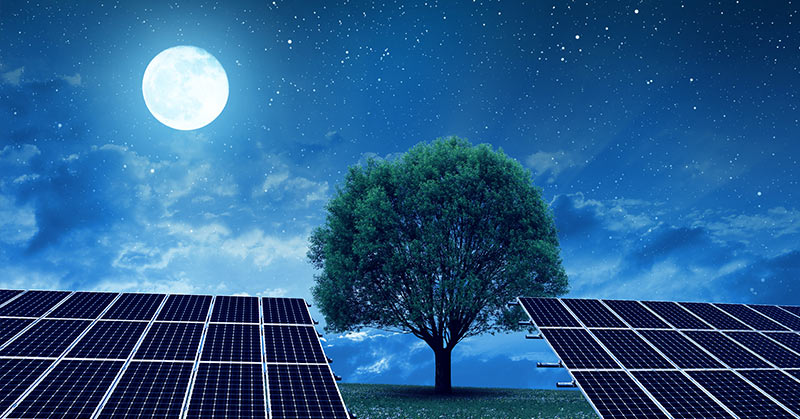Solar power as a method of electricity generation has many advantages. It is a renewable and highly abundant resource, and it is sustainable, meaning it meets the needs of present populations without compromising the ability of future generations to meet their needs. Harnessing solar energy also does not, in general, produce any pollution (though the production of the panels can), it is available all over the world and can actually reduce electricity costs for individuals and businesses [1].
There are, however, some disadvantages to solar energy. The first is that expensive batteries are required to store energy produced by solar power. The second is that solar energy is an intermittent energy source, meaning that there are certain times when sunlight is more scarce, such as in the morning and at night. Overcast days can be difficult to predict, which is why solar power is not often used as a baseline energy source [1].
Anti-Solar Cells
While the idea of solar panels that work at night may sound like science-fiction, they could become a reality sooner than you think. Jeremy Munday, an engineering professor at the University of California Davis, is in the process of developing a prototype for an “anti-solar” cell that would work opposite to the way a typical solar panel functions [2].
The professor in the Department of Electrical and Computer Engineering is developing a specially-designed photovoltaic cell that could generate up to fifty watts of power per square meter at night [2].
Read: Kenya Installs the First Solar Plant That Transforms Ocean Water Into Drinking Water
How Does the Process Work?
Traditional solar panels are made up of many smaller units called photovoltaic cells, which are cells that convert sunlight into energy. Each cell is made up of two “slices” of semi-conductive material, like silicon. Negatively-charged phosphorus is added on the top layer, and positively-charged boron is added on the bottom layer, creating an electric force field. When sunlight hits the cells, the light particles knock the electrons out of atoms and they get pushed out of this electronic junction.
Metal plates on the sides of the cells collect the electrons and transfer them to wires, where they then flow along the circuit in the same way as any other source of electricity [3].
Anti-solar cells work in the same way as traditional solar panels but in the reverse. Traditional solar panels are cool compared to the sun, so they will absorb light. If an object is hot compared to its surroundings, on the other hand, it will radiate heat in the form of infrared light. A “nighttime photovoltaic cell” would use the earth as a heat source and the night sky as a heat sink [2,4].
Munday’s thermoradiative cells, which generate power by radiating heat into their surroundings, would heat up and point at the night sky, which is a much cooler “object”, and radiate heat as infrared light [6]. He explained the basics of the process in a statement:
“A regular solar cell generates power by absorbing sunlight, which causes a voltage to appear across the device and for current to flow. In these new devices, light is instead emitted and the current and voltage go in the opposite direction, but you still generate power,” Munday said in a statement. “You have to use different materials, but the physics is the same.” [5]
The Benefits of Anti-Solar Cells
Storage has been one of the largest stumbling blocks for the solar industry. IN order to store excess solar energy for use during the night or when the sun is obscured, solar panels rely on either expensive batteries or net metering to continue to deliver power. Surplus power that was generated during sunlight hours is transferred to a public utility power grid, which is often powered by fossil fuels. Munday’s cells would solve this problem.
“Solar cells are limited in that they can only work during the day, whereas these devices can work 24/7, which is the real advantage,” Munday told CNN. “Nobody wants to lose power once the sun sets.” [5]
These new panels would work during the day as well, as long as they were shielded from direct sunlight. This would allow them to operate twenty-four hours a day, which could help to balance out the power grid over a day-to-night cycle [2].
The anti-solar cells could also help achieve carbon neutrality, because they could run on wasted heat leftover from industrial processes. Carbon emissions would be balanced with carbon removal, so no net carbon would be released [5].
Read: Transparent Solar Panels Will Turn Windows Into Green Energy Collectors
Limitations
The panels are still in the developmental phase and do require continued work. Currently, the prototype Munday has developed only produces about twenty-five percent of the energy that traditional solar panels produce in a day, but he is confident that further development will produce even more effective panels [5].
As Munday and others continue to work on projects such as this, we may one day soon be able to use solar power as a baseline energy source.
Keep Reading: Affordable Solar Homes Produce as Much Energy as They Use
Sources
- https://energyinformative.org/solar-energy-pros-and-cons/
- https://www.ucdavis.edu/news/anti-solar-cells-photovoltaic-cell-works-night
- https://www.livescience.com/41995-how-do-solar-panels-work.html
- https://pubs.acs.org/doi/pdf/10.1021/acsphotonics.9b00679
- https://www.cnn.com/2020/02/05/us/solar-panels-work-at-night-scn-trnd/index.html
- https://www.sciencedaily.com/releases/2020/01/200129174512.htm

